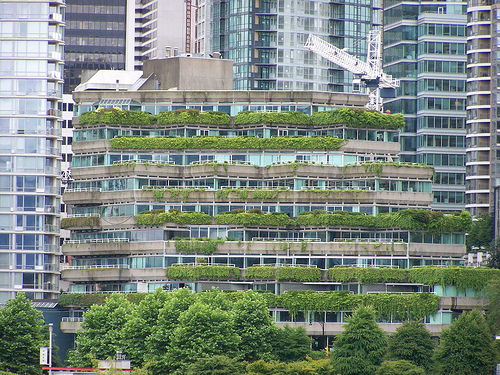
Can “Living” Buildings Help Fight Climate Change?

This was originally posted on CrispGreen.com
New research suggests protocell “skins” could be the secret to building carbon-negative architecture.
Researchers in Europe are collaborating on a project to develop materials that could eventually make it possible for buildings to produce water in desert environments or harvest sunlight to produce biofuels.
The University of Greenwich’s School of Architecture & Construction is poised to use ethical synthetic biology to create “living” materials that could be used to clad buildings and help combat the effects of climate change.
The idea is to use protocells – bubbles of oil in an aqueous fluid sensitive to light or different chemicals – to fix carbon from the atmosphere or to create a protective shell around the buildings, to protect them from erosion.
Professor Neil Spiller, an architect and head of the University of Greenwich’s School of Architecture & Construction, said the research team was looking at methods of using responsive protocells to clad cities in an ethical, green and sustainable way.
“We want to use protocell bubbles to fix carbon or precipitate skin that we can then develop into a coral-like architecture, which could petrify the piles that support Venice to spread the structural weight-load of the city,” Professor Spiller said.
The Center for Fundamental Living Technology at the University of Southern Denmark has managed to get these cells to capture carbon dioxide from solution and convert it into carbon-containing materials. Such cells could be used to fix carbon to create ways of building carbon-negative architecture.
An installation displayed at the Venice Biennale 2010, “Hylozoic Ground,” provides an example of how protocells may be used to create carbon-negative architectures (above). Created by Canadian architect Philip Beesley, and fitted with protocells designed by Dr. Rachel Armstrong of UCL’s Bartlett School of Architecture, the installation recycles carbon dioxide exhaled by visitors into carbon-containing solids. Similar deposits could be used to stabilize the floating city’s foundations by growing an artificial limestone reef beneath it.
Although synthetic biology contains huge promises for society, research warns that there could also be large potential perils. Consider this excerpt from a 2007 paper on the ethics of synthetic biology.
…It could provide us with large quantities of biofuels without using land that can also be used to produce food. It could also provide large quantities of cheap anti-malaria medicine. Conversely, synthetic biology could lead to the creation of more lethal and virulent pathogens, which might be used in a terrorist attack. Moreover, synthetic biology will make discussions necessary about fundamental concepts like nature and life.
Whether it’s living roofs, protocell clad buildings, or vertical farming structures, one thing is certain: with more people flocking to urban centers it’s become increasingly important to develop a plan for keeping these cities green and breathable.



















